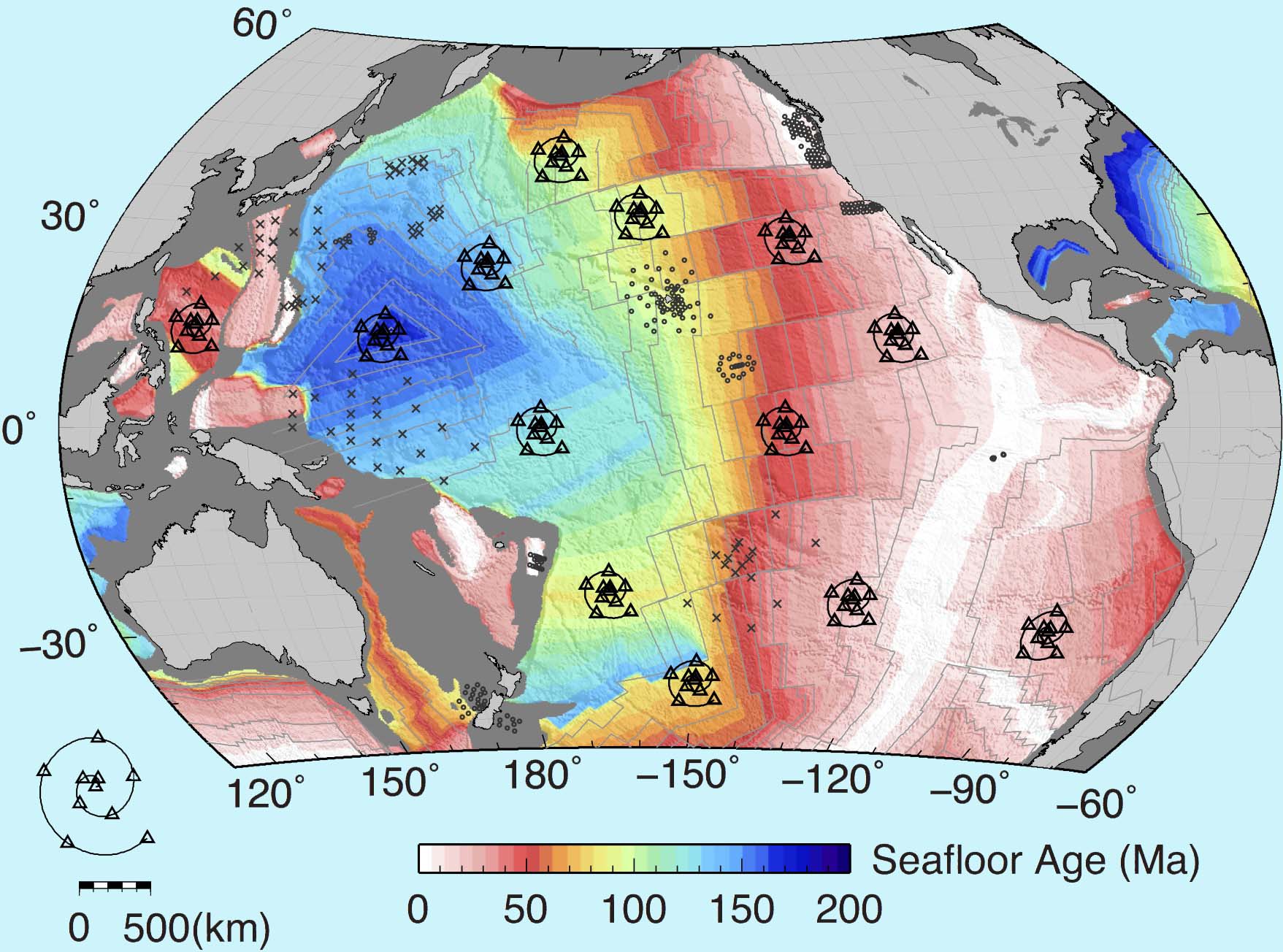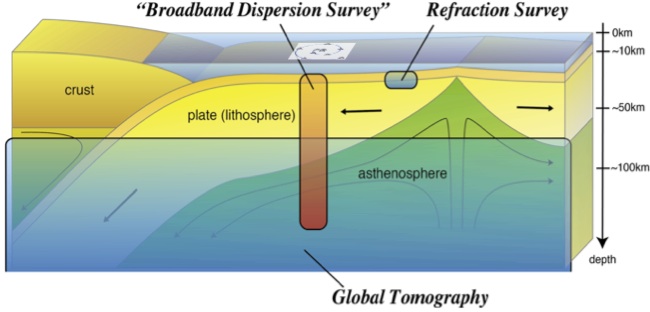Pacific Array
Based on recent developments on broadband ocean bottom seismometry,
we propose a next generation large-scale array experiment in the ocean.
Recent advances in ocean bottom broadband seismometry(Ref 1),
together with advances in the seismic analysis methodology(2),
have enabled us to resolve the regional 1-D structure of the
entire lithosphere/asthenosphere system, including seismic
anisotropy (azimuthal(3), and hopefully radial),
with deployments of ~15 broadband ocean bottom seismometers (BBOBSs).
Having ~15 BBOBSs as an array unit for a 2-year deployment,
and repeating such deployments in a leap-frog way or concurrently
(an array of arrays) for a decade or so would enable us to cover
a large portion of the Pacific basin. Such efforts, not only
by giving regional constraints on the 1-D structure beneath Pacific ocean,
but also by sharing waveform data for global scale waveform tomography,
would drastically increase our knowledge of how plate tectonics works
on this planet, as well as how it worked for the past 150 million years.
International collaborations is essential:
if three countries/institutions participate this endeavor together,
Pacific Array may be accomplished within five-or-so years.

Fig. 1. Conceptual image of Pacific Array.
The unit array here consists of 10 BBOBSs distributed in
a spiral form for a better wavenumber coverage,
but actual array configuration should be carefully optimized.
The location of unit arrays is also ad-hoc-ly chosen.
Crosses and small open circles are existing BBOBS deployments
conducted respectively by Japanese and US scientists.
Although plate tectonics was developed nearly 50 years ago,
the detail of the mechanism how it works is still poorly known.
In recent years, the elucidation of the lithosphere/asthenosphere-boundary (LAB)
and -system (LAS) have become one of the hot topics in solid earth science(Ref 4).
The major obstacle that hampers our understanding under ocean,
where the most simple and representative system of plate tectonics
is expected to be found, is our inability to image it well.
In seismology for example, while the active seismic refraction survey has been
successful, only top 10km or so below oceanic MOHO can be investigated.
Although surface wave tomography has been used to image the large scale
structure in the oceanic areas, we have to make assumptions for the structure of
the top 50km that are likely to introduce biases in the estimates of deeper structure.
In addition, there has been limited discussion about the intensity of seismic
anisotropy because of the difficulty of estimating the absolute value
of seismic anisotropy by surface-wave tomography studies.
It is, thus, essential to establish means to fill the gap between these two approaches.
Recent advances in ocean bottom broadband seismometry,
together with advances in the seismic analysis methodology,
have enabled us to resolve the regional 1-D structure of
the entire lithosphere/asthenosphere system, including seismic
anisotropy (azimuthal, and hopefully radial),
with deployments of ~10-15 BBOBSs (e.g., Takeo et al., 2013, 2016; Lin et al., 2016, Ref. 9).
We have developed a multi-band method for the ocean-bottom broadband dispersion survey.
The method utilizes seismic surface waves at periods of 3-150s
(ambient noise for 3-30s, and teleseismic surface-waves for 30-150s)
recorded by arrays of BBOBSs. This broadband dispersion measurement allows
us to obtain one-dimensional isotropic and anisotropic structure beneath the
array from the surface to a depth of ~150km (Figure 1).
We have thus succeeded to model the entire oceanic lithosphere/asthenosphere
system without a priori assumption for the shallow-most structure,
the assumption often made for the global surface wave tomography.

Fig. 2 Example result of ocean-bottom broadband dispersion survey.
Combining the seismic interferometry and event analysis,
in-situ broadband Rayleigh wave dispersion curves and a
corresponding 1D S-wave structure are obtained beneath
Philippine Sea (after Takeo et al., 2013, JGR).
Similarly, azimuthal anisotropy can be estimated as a
function of frequency and depth (Takeo et al., 2016).
The broadband dispersion survey will provide a new tool
for ocean geoscience by which the structure of the entire
oceanic lithosphere/asthenosphere system can be determined.
The application of such broadband ocean bottom seismology for
a variety of ocean basins, not only by giving regional constraints
on the 1-D structure (including seismic anisotropy), but also by
sharing waveform data for global scale waveform
tomography(5,6,7), would drastically increase our knowledge of how plate
tectonics works beneath oceanic basins, as well as of the
large scale picture of the interior of the Earth.

Fig. 3 Conceptual diagram of ocean-bottom broadband dispersion survey.
Pacific Array initiative
Above realization has led us to propose a next generation large-scale array
experiment in the ocean, Pacific Array.
Constructing a seismic network in the ocean has been one of the
most challenging tasks in (global) seismology. Such a network is essential for our understanding
of the Earth's interior as nearly 70% of the Earth's surface is covered by the ocean.
International communities had attempted to make this to happen
(e.g., ION symposium,
http://eri-ndc.eri.u-tokyo.ac.jp/OHP-sympo2/;
Forsyth and Detrick, 2003(Ref 8)), but have never succeeded for various reasons.
Advances in broadband ocean bottom seismology,
however, have opened a new and promising possibility for this "dream" to come true.
The basic concept of Pacific Array may be summarized as follows:
-
unit array: ~15 BBOBS deployed for a period of ~2 years OBEM,
pressure sensor, etc.. may be deployed as well
- large array: 10~15 sites in Pacific ocean, or other oceans
- broadband dispersion survey (+RF, SWS)
1D isotropy & anisotropy structure
constraint for global tomography
-
waveform data share for full waveform/adjoint tomography & deep earth studies
-
international & inter-community collaborations
For Pacific Array to be realized, international collaboration seems essential.
If three or four countries/institutions collaborate together,
it may be achieved within a 10-year time frame that makes Pacific
Array concept attractive. It is also essential that global seismology,
geodynamics, and deep earth (GSGD) communities work closely with
the ocean science community for Pacific Array to happen.
While unit array deployments may have theirs own scientific goals, it is
important that they are planned to fit within a larger international Pacific Array
structure. ION (International Ocean Network) committee, at the last
AGU business meeting in 2015, has agreed to give some support for this initiative,
possibly by providing such an international umbrella for it.
References:
-
Suetsugu D. and H. Shiobara (2014), Broadband Ocean-Bottom Seismology, Annu. Rev. Earth Planet. Sci. 2014. 42:27
-
Takeo, A., K. Nishida, T. Isse, H. Kawakatsu, H. Shiobara, H. Sugioka, and T. Kanazawa (2013), Radially anisotropic structure beneath the Shikoku Basin from broadband surface wave analysis of ocean bottom seismometer records, J. Geophys. Res., 118 (6), 2878-2892, doi:10.1002/jgrb.50219.
-
Takeo, A., H. Kawakatsu, T. Isse, K. Nishida, D. Suetsugu, H. Shiobara, H. Sugioka, and A. Ito (2016), Intensity of seismic azimuthal anisotropy in the oceanic lithosphere and asthenosphere from broadband surface-wave analysis of OBS array records at 60 Ma seafloor, J. Geophys. Res., 121, 1927-1947, doi:10.1002/2015JB012429.
-
Kawakatsu, H. (2012), At the bottom of the oceanic plate (Perspective), Science, 335, 1448-1449.
-
Zhu, H., and J. Tromp (2013), Mapping Tectonic Deformation in the Crust and Upper Mantle Beneath Europe and the North Atlantic Ocean, Science, 341, 871-875.
-
French, S., V. Lekic, B. Romanowicz (2013), Waveform Tomography Reveals Channeled Flow at the Base of the Oceanic Asthenosphere, Science, 342, 227-230.
-
Fichtner, A., B.L.N. Kennett, H. Igel, H.-P. Bunge (2010), Full waveform tomography for radially anisotropic structure: New insights into present and past states of the Australasian upper mantle, Earth Planet. Science Lett., 290, 270-280.
-
Forsyth, D.W., and Detrick, B.S. (2003), Probing Geodynamic Processes Beneath the Sea Floor, Eos Trans., AGU, 84, 517-523.
-
Lin, P-Y. P., J. B. Gaherty, G. Jin, J. A. Collins, D. Lizarralde, R. L. Evans, G. Hirth (2016),
High-resolution seismic constraints on flow dynamics in the oceanic asthenosphere, Nature, 535, 538–54.


